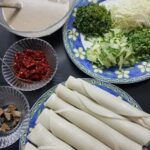Laksam: The White Laksa from Kelantan & Terengganu
Laksam, the captivating white laksa of Kelantan and Terengganu in Malaysia, introduces a refreshing twist to the world of laksa. Unlike the vibrant and familiar laksa we know, Laksam presents itself in an entirely different form. Say goodbye to the orange-hued broth and thin noodles, and welcome the delight of rolled rice noodles served with a luscious white gravy.
The true essence of Laksam lies in its rich and creamy gravy. This unique gravy does not rely on curry paste for its flavours. Instead, it incorporates a medley of ingredients such as coconut milk, fish paste, asam gelugor (tamarind slices), ginger, shallots, garlic, black pepper, salt, and sugar. The fish paste used is typically made from deboned varieties like ikan kembung, ikan selar, ikan selayang, or ikan tamban. In some instances, eels are also used to enhance the flavours. The resulting gravy boasts a delightful balance of richness, sweetness, savoury notes, and a hint of tanginess.
The noodles used in Laksam, which share the same name as the dish, are distinct and made from scratch. The laksam noodle batter is a mixture of rice flour, plain flour, water, cooking oil, and salt. A small amount of the batter is spread onto an oiled tray or plate, creating a layer approximately 5mm thick to determine the noodle’s thickness. The tray or plate is then steamed for a few minutes until the batter transforms into a thin rice cake. The rice cake is carefully rolled into a log and allowed to cool. This process is repeated until all the batter is utilized. Before serving, the log is cut into bite-sized pieces of noodles that offer a nice softness and slight springiness. Laksam noodles are rarely available pre-packaged and are typically prepared by home cooks or skilled restaurant chefs.
To complement the white-on-white presentation of Laksam, a vibrant and refreshing ulam (raw herb and vegetable salad) is served alongside the dish. Sliced cucumbers, green beans, cabbage, torch ginger flowers, bean sprouts, and laksa leaves are common additions. Not only do these ulam provide a burst of colour, but they also contribute nutritious fibers to the overall dish.
No Laksam experience is complete without the addition of spicy sambal. Made with chilies and belacan (shrimp paste), the sambal adds an extra layer of heat and flavour to the dish. Its vibrant red hue transforms the visual appeal of Laksam, enhancing the overall dining experience.
While Laksam is widely available in Kelantan and Terengganu, its popularity has spread to other parts of Malaysia, particularly during Ramadhan markets. In addition, you can even find this delightful dish in southern Thailand. It’s worth noting that Laksam from Kelantan tends to be sweeter, while the Terengganu version leans more towards savoury flavors. Traditionally, Laksam was enjoyed by hand due to the thick gravy, but nowadays, utensils are commonly used.




